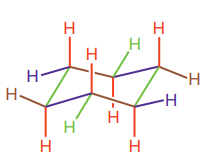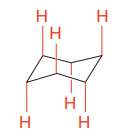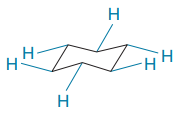
Concept explainers
Interpretation:
For the given Newman projection of cyclohexane, all the
Concept introduction:
Newman projection is a two-dimensional representation of a molecule viewed down the bond of interest. In a Newman projection, two atoms directly connected by the bond of interest are shown explicitly. The nearer atom is depicted as a point while the more distant atom is depicted as a circle. Bonds of the front (nearer) atom converge at the point whereas bonds to the back atom connect to the circle. The bond of interest is not visible; instead it must be imagined as connecting the front and the back carbon atoms. In cyclohexane, all six carbon atoms are completely indistinguishable, but there are two different types of hydrogen atoms; six hydrogen atoms occupy the equatorial positions and six occupy the axial position. Each carbon atom in cyclohexane is bonded to one of each. The basic framework of chair form of cyclohexane is:

Axial bonds are alternate up and worn around the ring (highlighted in red). Equatorial bonds are alternate slightly up and down around the ring (highlighted in blue).


In the rotational conformations, the bonds which are up remain up and the bonds which are down remain down.
Trending nowThis is a popular solution!

Chapter 4 Solutions
EBK ORGANIC CHEMISTRY: PRINCIPLES AND M
- CH₂O and 22 NMR Solvent: CDCl3 IR Solvent: neat 4000 3000 2000 1500 1000 15 [ اند 6,5 9.8 3.0 7.0 6.0 5.0 4.8 3.0 2.0 1.0 9.8 200 100arrow_forwardprotons. Calculate the mass (in grams) of H3AsO4 (MW=141.9416) needed to produce 3.125 x 1026arrow_forwardPlease provide with answer, steps and explanation of ideas to solve.arrow_forward
- Please provide with answer, steps and explanation of ideas to solve.arrow_forwardPlease provide with answer, steps and explanation of ideas to solve.arrow_forwardUsing what we have learned in CHEM 2310 and up through class on 1/31, propose a series of reaction steps to achieve the transformation below. Be sure to show all reagents and intermediates for full credit. You do not need to draw mechanism arrows, but you do need to include charges where appropriate. If you do not put your group name, you will get half credit at most. ? Brarrow_forward
 Organic ChemistryChemistryISBN:9781305580350Author:William H. Brown, Brent L. Iverson, Eric Anslyn, Christopher S. FootePublisher:Cengage Learning
Organic ChemistryChemistryISBN:9781305580350Author:William H. Brown, Brent L. Iverson, Eric Anslyn, Christopher S. FootePublisher:Cengage Learning Organic Chemistry: A Guided InquiryChemistryISBN:9780618974122Author:Andrei StraumanisPublisher:Cengage Learning
Organic Chemistry: A Guided InquiryChemistryISBN:9780618974122Author:Andrei StraumanisPublisher:Cengage Learning


